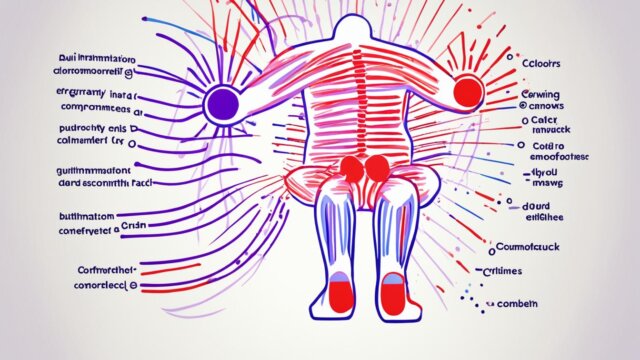FTC disclaimer: This post may contains affiliate links and we will be compensated if you click on a link and make a purchase.
Every year, about 8,490 new cases of Chronic Myeloid Leukemia (CML) happen in the United States. This shows how big of an impact this blood cancer has. Thanks to new treatments, CML is now a condition that most people can manage. Since 2001, people with CML can live longer and feel less sick from treatment.
CML is a long-term leukemia that affects the blood and bone marrow. It makes too many immature white blood cells. This can mess up the bone marrow and cause problems. Knowing about CML is key for those dealing with it and their families.
Key Takeaways
- Chronic Myeloid Leukemia (CML) is a type of blood cancer that affects the production of white blood cells.
- CML is usually diagnosed in its chronic phase, when treatment is most effective for most patients.
- Targeted therapies like tyrosine kinase inhibitors (TKIs) have transformed CML from a life-threatening disease to a manageable chronic condition.
- The risk of CML increases with age, and men are slightly more likely to develop the disease.
- Radiation exposure, especially high doses, can increase the risk of CML.
What is Chronic Myeloid Leukemia?
Definition and Overview
Chronic myeloid leukemia (CML) is a cancer that affects the blood and bone marrow. It grows slowly but can turn into a fast-growing disease hard to treat. In CML, the bone marrow makes too many white blood cells called granulocytes. This stops normal blood cells from growing.
CML makes the immune system weak because the cells don’t mature fully. It happens when a genetic change creates an abnormal gene called BCR-ABL in myeloid cells. CML is one of four main leukemia types. People with CML usually live longer than those with acute leukemia.
CML mostly affects older adults but can happen at any age, even in children. About 90% of CML patients have the Philadelphia chromosome in their blood cells. Men are more likely to get CML than women, and radiation therapy can increase the risk.
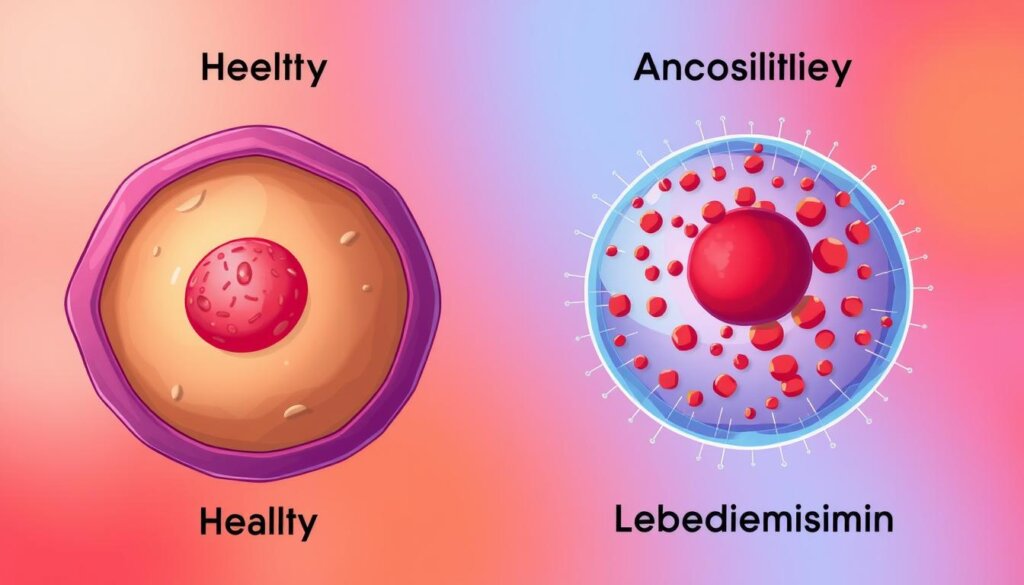
CML is more common in adults and rarely in children. Most people with CML have the Philadelphia chromosome. Symptoms include feeling tired and losing weight.
The treatment and outlook for CML depend on several factors. These include the patient’s age, the disease’s phase, and their overall health. CML can come back after treatment, so constant monitoring is key.
Causes and Risk Factors
The exact cause of Chronic Myeloid Leukemia (CML) is still a mystery. But, it’s linked to a specific chromosomal change called the Philadelphia chromosome. This change happens when a piece of chromosome 22 breaks off and joins chromosome 9. This creates a fusion gene called BCR-ABL1.
The BCR-ABL1 fusion gene makes an abnormal protein. This protein helps CML cells grow and live longer. This leads to the disease.
The Philadelphia Chromosome
The Philadelphia chromosome is a key sign of CML and is found in most cases. It’s not passed down from parents. Instead, it happens by chance during a person’s life.
Researchers don’t know all the reasons for this change. But, they’ve found some risk factors for CML.
- Older age: The risk of CML goes up with age, especially in adults after middle age.
- Gender: Men are slightly more likely to get CML than women.
- Radiation exposure: Getting a lot of radiation, like from cancer treatments or nuclear accidents, raises the risk of CML.
CML isn’t caused by smoking, diet, chemicals, or infections. It’s also not passed down from parents to children.
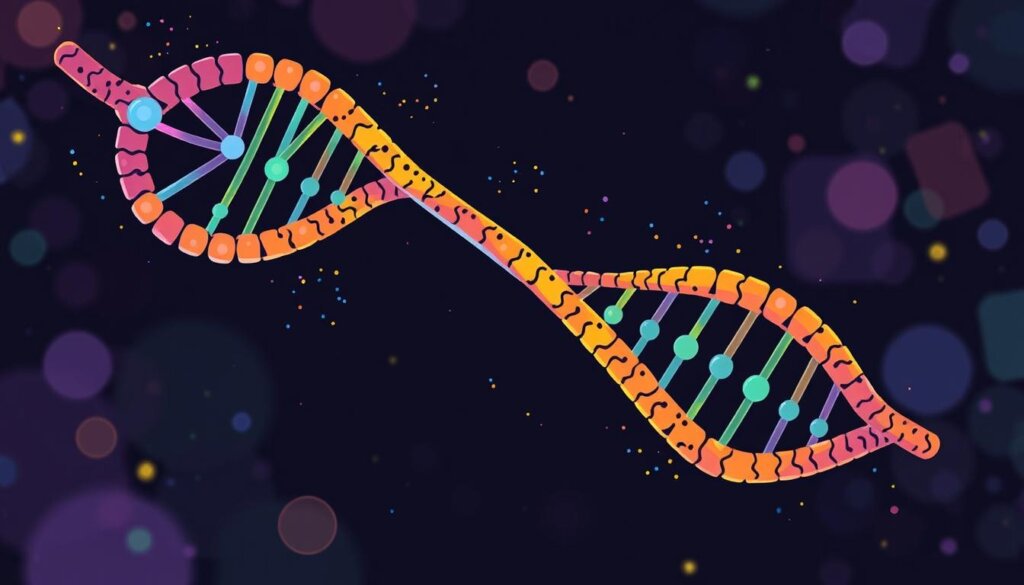
“The Philadelphia chromosome is the hallmark of Chronic Myeloid Leukemia and is present in the majority of cases.”
Symptoms and Diagnosis
Chronic myeloid leukemia (CML) can often be diagnosed before symptoms show up. Some people might feel weak, tired, or have night sweats and weight loss. They might also have fever, bone pain, or an enlarged spleen.
Interestingly, the signs and symptoms of CML do not differ by sex or gender.
One key sign of CML is an abnormal white blood cell count. This is often found during routine blood tests or health check-ups. To diagnose CML, several tests are done:
- Blood tests check for anemia, leukopenia, neutropenia, and thrombocytopenia, common in CML patients.
- A bone marrow biopsy looks at abnormal cells and checks for the Philadelphia (Ph) chromosome, found in about 95% of CML patients.
- More tests, like chromosome analysis, Fluorescence In Situ Hybridization (FISH), and Reverse Transcription Polymerase Chain Reaction (RT-PCR), are used to find the BCR-ABL1 fusion gene for a more accurate diagnosis.
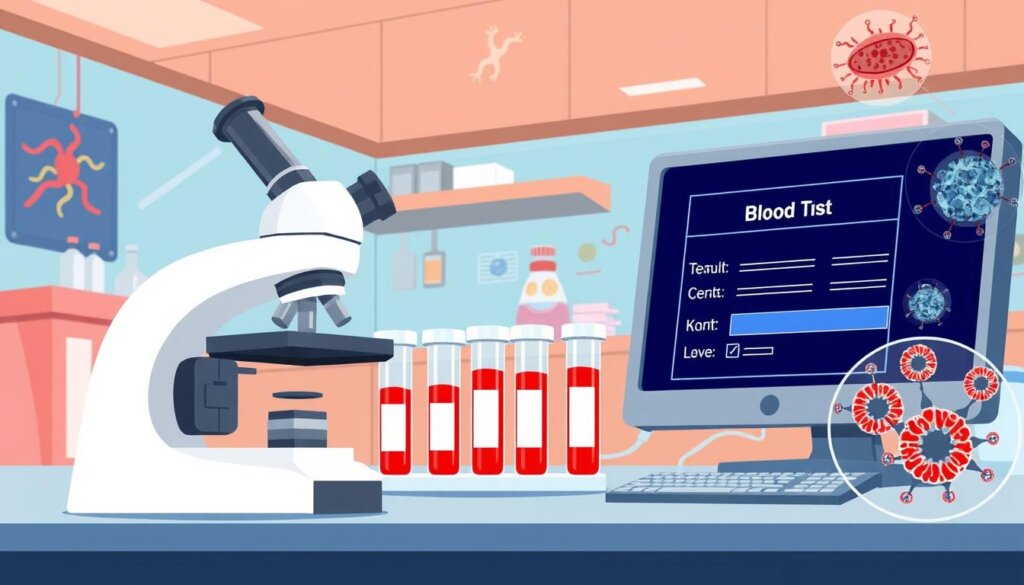
Diagnostic Test | Purpose |
|---|---|
Blood Tests | Assess the levels of different blood cells, including anemia, leukopenia, neutropenia, and thrombocytopenia. |
Bone Marrow Biopsy | Examine the abnormal cells and detect the presence of the Philadelphia (Ph) chromosome. |
Cytogenetics | Analyze chromosomal abnormalities to confirm the CML diagnosis. |
FISH | Provide a more sensitive method for detecting the BCR-ABL1 fusion gene. |
RT-PCR | Highly sensitive test that can detect one CML cell among 100,000 normal cells. |
By using these tests together, doctors can accurately diagnose CML and plan the best treatment for each patient.
“Early detection and prompt treatment are crucial for managing chronic myeloid leukemia effectively.”
Chronic Myeloid Leukemia Phases
Chronic Myeloid Leukemia (CML) has three main phases. These phases are based on the number of immature cells in the blood and bone marrow. Knowing these phases helps doctors choose the right treatment and guess how the disease will progress.
Chronic Phase
The chronic phase is the first and easiest stage of CML. It’s when there are less than 10% blasts in the blood or bone marrow. At this time, doctors can usually keep the disease under control with special treatments.
Accelerated Phase
The accelerated phase happens when there are 15% or more blasts in the blood or other signs. This stage is harder to treat. The disease can grow faster here.
Blast Phase
The blast phase, or blast crisis, is when 20% or more of the cells in the bone marrow and/or blood are blasts. This is the most aggressive and hard-to-manage stage. The disease turns into a more serious form of leukemia here.
Things that might affect how long someone with CML will live include being in the accelerated or blast phase, a big spleen, bone damage, certain blood counts, being 60 or older, and many chromosome changes in CML cells. The Sokal and Euro scoring systems also help guess how well someone will do. But, their use with new treatments is not always clear.
If the disease is not treated well, it can move from one phase to the next. It’s very important for patients and doctors to understand the different phases of CML. This helps make better treatment choices and manage the disease well.
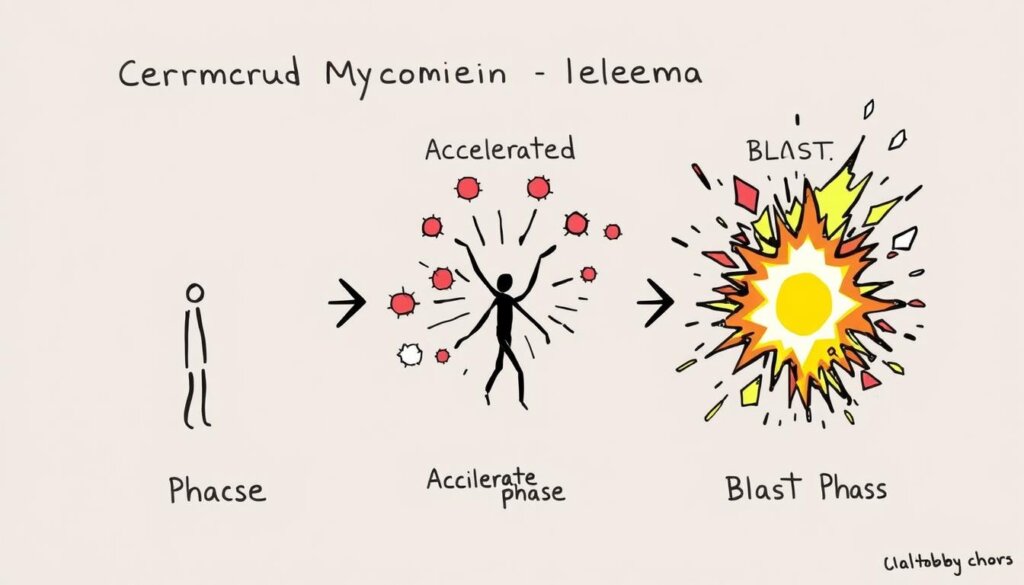
Treatment Options
Managing Chronic Myeloid Leukemia (CML) focuses on targeted therapy. This uses tyrosine kinase inhibitors (TKIs) like imatinib (Gleevec), dasatinib (Sprycel), and nilotinib (Tasigna). These drugs block the BCR-ABL1 protein that makes CML cells grow.
TKIs are very effective, especially in the chronic phase of CML. But for those not responding to TKIs or in more advanced phases, stem cell transplantation is an option. This is especially true if a donor is available.
Stem Cell Transplantation
Stem cell transplantation, or bone marrow transplant, aims to replace bad CML cells with healthy ones. It uses high-dose chemotherapy or radiation to kill the old bone marrow. Then, stem cells from a donor are given to make a new, healthy blood and immune system.
This method can cure CML but is usually for those who have tried other treatments. It’s risky, with possible side effects like graft-versus-host disease and infections.
For aggressive CML, chemotherapy might be used with targeted therapy. Clinical trials also offer new treatments, but the risks are not always clear.
Other treatments like acupuncture and yoga can help with CML’s side effects and fatigue.
Every CML treatment plan is different. It depends on the patient, the disease stage, and how well they respond to treatment. Regular check-ups and talking to doctors are key for the best results.
Monitoring and Response
Patients with chronic myeloid leukemia (CML) get regular checks to see how well they’re doing. This detailed monitoring uses blood tests to check on several things. These include blood cell counts, the presence of certain cells, and the levels of specific genes.
The main goal is to get the disease to a very low level. This is called a deep molecular response. It means the disease is almost gone and leads to better long-term results.
When the disease level is very low, it’s unlikely to get worse. It also means the chance of getting even better is high.
Response Type | Definition |
|---|---|
Hematologic Response | Normalization of blood cell counts |
Cytogenetic Response | Disappearance of cells with the Philadelphia chromosome |
Molecular Response | Reduction or disappearance of the BCR-ABL1 fusion gene |
Regular blood tests and bone marrow checks are key. They help track how well the treatment is working. Tests for specific genes are needed every few months at first. Later, they can be done less often if the disease is under control.
Doctors use these tests to adjust treatment plans as needed. This careful monitoring is crucial for managing CML.
“Achieving a deep molecular response is the goal of CML treatment, as it indicates a very low level of detectable disease and is associated with the best long-term outcomes.”
Living with Chronic Myeloid Leukemia
Living with chronic myeloid leukemia (CML) means watching your health closely. You’ll need to take a daily pill called a tyrosine kinase inhibitor (TKI). Some people can get rid of the cancer with treatment. But for many, TKI therapy keeps the cancer in check for years. Still, managing CML as a long-term condition can be tough and stressful, as there’s no cure.
It’s key to take your TKIs just as your doctor says. Avoid other medicines or supplements that might mess with your TKIs. Side effects like tiredness, nausea, and muscle cramps can happen. But, changing your dose or schedule might help. Keeping a diary of your symptoms can help you manage them better.
Staying healthy is also important. Eating well, with lots of plants, whole grains, nuts, fish, and healthy fats, can help. Also, exercising regularly, like 150 minutes of aerobic activity a week, is good for CML patients.
Money matters too. Treatment can be expensive, even with insurance. Not taking your TKIs as directed can make things worse. Luckily, there are ways to get help, like cheaper medicine and copay assistance from groups like the American Cancer Society.
It’s also important to get emotional support. Joining support groups or talking to therapists can be really helpful. Some employers might also offer special help, like flexible work hours, under the Family and Medical Leave Act.
In short, managing CML needs a lot of effort. This includes sticking to your treatment, dealing with side effects, staying healthy, handling money issues, and getting emotional support. With the right care, most people with CML can live well and have a long life.
Support and Resources
Getting a CML diagnosis can feel overwhelming. But, many resources and support services are here to help. Patient groups like the Leukemia & Lymphoma Society offer educational materials and financial help. They also have peer support programs.
The CML Advocates Network links 100 leukemia groups from 80 countries. The National CML Society in the U.S. gives patients and families a place to find information.
Patients can talk to doctors, join online groups, and find ways to manage CML’s practical and emotional sides. The Leukemia & Lymphoma Society’s First Connection Program matches patients with others facing similar issues. Online groups, like those on Facebook, connect CML patients worldwide.
Connecting with others who get what it’s like to live with CML is really helpful. Whether it’s in-person groups or online, patients can find the support they need.
Groups like Cancer Research UK and Blood Cancer UK offer lots of information and help. Young Adult Survivors United helps those 18–39 with cancer, giving up to $500 for living costs. Macmillan Cancer Support and the American Cancer Society also help with booklets and factsheets on CML.
“The support and resources for CML patients are truly invaluable. They offer emotional, financial, and practical help, making a big difference during tough times.”
Whether you’re new to CML or have been dealing with it for years, there’s help available. Use these resources to connect, learn, and thrive on your CML journey.
Chronic Myeloid Leukemia Research
Research has made big strides in fighting chronic myeloid leukemia (CML). Scientists are working hard to make treatments better. They aim to improve life quality and control for those with this blood cancer.
New clinical trials are looking at new treatments for CML. This includes testing higher doses of certain drugs and combining them with other treatments. Researchers are also studying how to stop treatment for a while and handle disease return.
Scientists are looking for new drugs to fight CML, especially for those who don’t respond to current treatments. Ponatinib is a drug that works against a tough mutation in the BCR-ABL gene. Many drugs, including immunotherapy, are being tested with TKIs to improve treatment results.
Researchers are also looking into cancer vaccines for CML, though more study is needed. These new ideas in CML research offer hope for better treatments and a possible cure.
CML mostly affects older people, with half of cases in those over 65. But thanks to new drugs, the five-year survival rate is over 70%. CML is rare in kids, making up only 3% of childhood leukemias.
The work in CML research is promising for better life quality and control for those with this blood cancer. The survival rate for CML is about 85% after ten years. The drug imatinib has saved around 350,000 lives since 2001.
But, there are still challenges like better diagnostics and understanding “deep remission”. More work is needed to target cancer stem cells and possibly cure the disease. The dedication of researchers and doctors is key to overcoming these challenges and improving care for patients.
“The ongoing research efforts in CML hold great promise for even better long-term control and quality of life for individuals living with this chronic blood cancer.”
Key CML Research Developments | Impact |
|---|---|
Investigating higher doses and combination therapies with TKIs | Potential for improved treatment responses |
Exploring TKI treatment discontinuation and disease recurrence management | Possibility of disease eradication and reduced long-term treatment burden |
Developing new drugs to combat TKI-resistant CML | Overcoming treatment challenges for patients with resistant disease |
Evaluating immunotherapy and cancer vaccine approaches | Harnessing the immune system to target and eliminate CML cells |
The ongoing research in CML, along with recent progress, offers hope for the future. By exploring new treatments and approaches, researchers and doctors aim to improve life quality and control for those with CML.
Conclusion
Chronic myeloid leukemia (CML) is a complex blood cancer. But, thanks to new treatments, it’s now more manageable. Targeted therapies, like tyrosine kinase inhibitors (TKIs), have changed CML from a deadly disease to a chronic one for many.
Even though CML is still a challenge, especially for those with advanced cases, research keeps moving forward. Scientists are looking into how CML has changed with TKI therapy. They’re also studying the risks of leukemia in different groups.
They’ve also found new ways to predict how CML will progress. They’re looking into how certain genetic changes affect CML. And they’re studying the role of the BCR-ABL fusion gene in CML.
As we learn more about CML, we’re working towards better outcomes. Some studies show it’s possible to stop TKI therapy for those in deep molecular remission. This could mean a life without daily medication for some.
By working with their healthcare team, people with CML can manage their condition well. This helps them live a good life despite the disease.
FAQ
What is chronic myeloid leukemia (CML)?
CML is a long-term form of leukemia. It’s a cancer of blood and bone marrow cells. It causes an increase in young white blood cells in the blood, bone marrow, and spleen.
What causes CML?
CML is caused by a chromosomal abnormality called the Philadelphia chromosome. This leads to an abnormal protein that makes CML cells grow and survive.
What are the symptoms of CML?
Symptoms of CML come on slowly. They include a big spleen, tiredness, bone pain, fevers, night sweats, and losing weight.
How is CML diagnosed?
Doctors use blood tests and a bone marrow biopsy to diagnose CML. They also do chromosome analysis, FISH, and RT-PCR to check for the Philadelphia chromosome and BCR-ABL1 fusion gene.
What are the different phases of CML?
CML has three phases: chronic, accelerated, and blast. These phases depend on the number of immature blast cells in the blood and bone marrow.
How is CML treated?
CML is mainly treated with tyrosine kinase inhibitors (TKIs). These block the BCR-ABL1 protein. For those not responding to TKIs, stem cell transplantation might be an option.
How is the response to CML treatment monitored?
Patients with CML have regular check-ups. These include blood tests to see how well the treatment is working.
What are the lifestyle considerations for living with CML?
Living with CML means following a treatment plan closely. It’s important to take TKIs as directed and avoid certain medications or supplements.
What support and resources are available for people with CML?
Organizations like the Leukemia & Lymphoma Society offer help. They provide educational materials, financial aid, and support groups. Patients can also find healthcare providers, join online communities, and get information on managing CML.
What is the future outlook for CML research and treatment?
CML research is making great strides. Scientists are working on new treatments and ways to cure CML. They’re exploring targeted therapies and combination treatments.
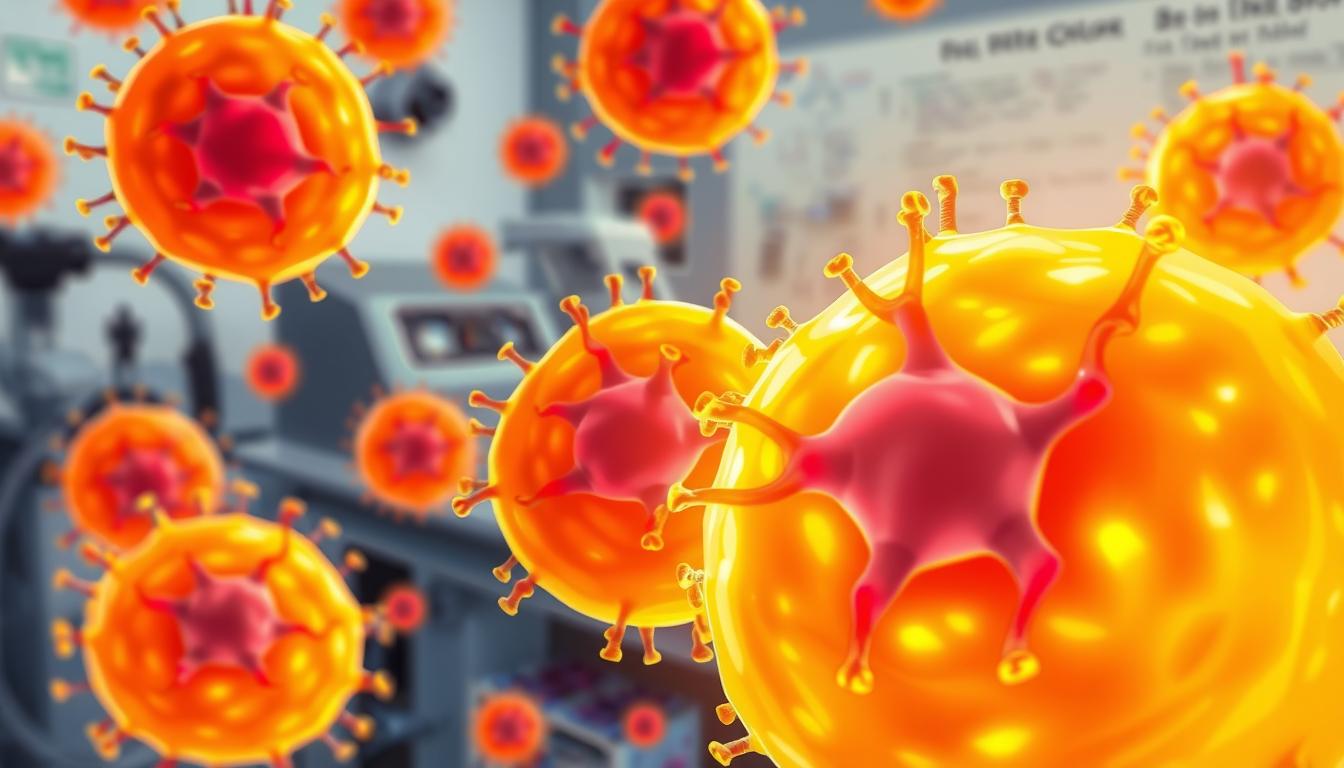




![8 Secrets of longevity: How to Live a Long and Happy Life [Definitive Guide]](https://healthyious.com/wp-content/uploads/2020/02/Secrets-of-longevity-how-to-live-long-life-640x360.jpg)
